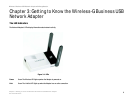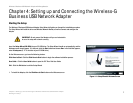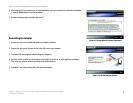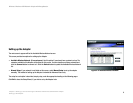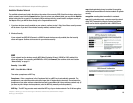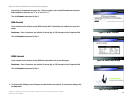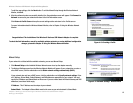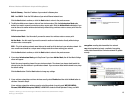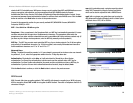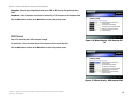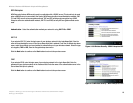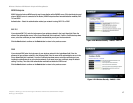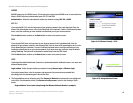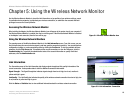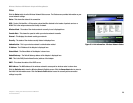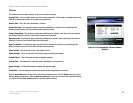
14
Chapter 4: Setting up and Connecting the Wireless-G Business USB Network Adapter
Setting up the Adapter
Wireless-G Business USB Network Adapter with RangeBooster
stands for Wi-Fi Protected Access. WPA uses a stronger security method than WEP and WPA2 defines an even
stronger encryption, authentication, and key management than WPA. RADIUS stands for Remote
Authentication Dial-In User Service. LEAP stands for Lightweight Extensible Authentication Protocol. It uses
username and password-based authentication between a wireless client and a RADIUS server. Click the Next
button to continue or the Back button to return to the previous screen.
Proceed to the appropriate section for your security method: WEP, WPA/WPA2-Personal, WPA/WPA2-
Enterprise, RADIUS, or LEAP.
WEP - Select 64-bit or 128-bit encryption
Passphrase - Enter a passphrase in the Passphrase field, so a WEP key is automatically generated. It is case-
sensitive and should not be longer than 16 alphanumeric characters. This passphrase must match the
passphrase of your other wireless network devices and is compatible with Linksys wireless products only. (If
you have any non-Linksys wireless products, enter the WEP key manually on those products.)
WEP Key - The WEP key you enter must match the WEP key of your wireless network. For 64-bit encryption,
enter exactly 10 hexadecimal characters. For 128-bit encryption, enter exactly 26 hexadecimal characters.
Valid hexadecimal characters are “0” to “9” and “A” to “F”.
Advanced Users
TX Key - The default transmit key number is 1. If your network’s access point or wireless router uses transmit
key number 2, 3, or 4, select the appropriate number from the TX Key drop-down box.
Authentication -The default is set to Auto, so it will auto-detect for Shared Key or Open System
authentication. For Shared Key authentication, both the sender and the recipient share a WEP key for
authentication. For Open System authentication, the sender and the recipient do not share a WEP key for
authentication. If you are not sure which authentication method to select, keep the default, Auto.
Click the Next button to continue, or click the Back button to return to the previous screen.
WPA Personal
WPA Personal offers two encryption methods, TKIP and AES, with dynamic encryption keys. WPA2 only uses
AES for encryption. Select TKIP or AES for encryption for WPA Personal. Then enter a Passphrase that is 8-63
characters in length.
Figure 4-14: Wireless Security - WPA Personal
wpa2 offers a stronger encryption than wpa by using the
AES (Advanced Encryption Standard) which is a block cipher
with block sizes of 128, 192 or 256 bits.
Figure 4-15: Wireless Security - WPA2 Personal
wpa (wi-fi protected access): a wireless security protocol
using TKIP (Temporal Key Integrity Protocol) encryption,
which can be used in conjunction with a RADIUS server.



